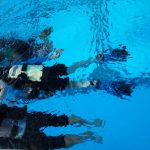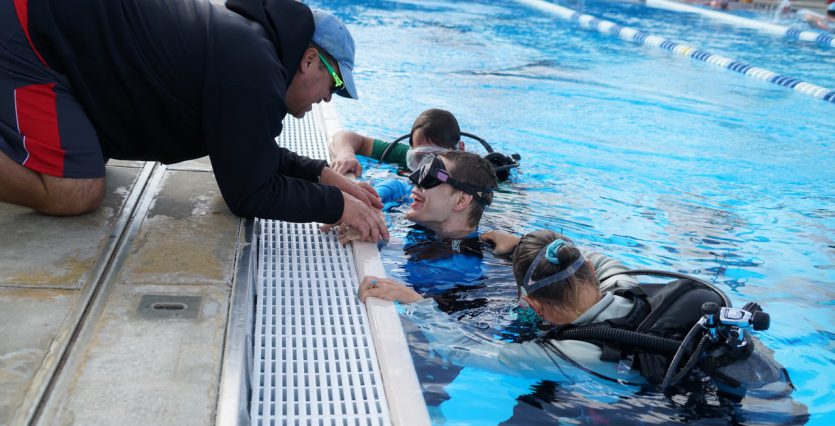Safety comes first in all situations, but when working with scuba divers who have special needs, security takes on a whole new meaning. As a facility approved for scuba therapy for people with special needs, protection is a concern to be tackled efficiently and thoughtfully.
Special needs scuba diving is an incredible adventure — for the divers and for the providers. At The Scuba Gym, our special needs divers have conditions that include autism, Down syndrome, cerebral palsy, spina bifida, hypotonia and more. The benefits for our divers are numerous. With our guidance, we are able to offer physical and occupational therapy with emotional therapeutic comforts as well.

Even though there are many advantages to working with divers with special needs, there are many safety factors to consider. Many of our divers are nonverbal and do not comprehend complications that might arise, and they start without any knowledge of scuba. Their scuba experiences outweigh the issues, and as instructors and dive leaders, we need to make adjustments to keep them safe.
The first step to safety is to sit down and talk to the individual with special needs. Finding out what they enjoy, what makes them comfortable, and what upsets them will give you a warning as to what might trigger your diver into a panic attack. If loud noises disturb your diver, and a swim coach is in another lane blowing his or her whistle, your diver could become alarmed. When meeting your individual, another consideration is evaluating their abilities. Many people who have special needs are people who have minor difficulties that would hardly affect their diving potential. Others appear to not have any complications, but upon discussion, you will find they are indeed in need of much attention, and some need physical and emotional support throughout their diving.
Another key factor in continuing safety is communication. Let other people using the same facility know who your divers are. Work together with swim coaches and pool staff on music volume levels, diving and swimming depths, and lane usage. Communicate also with the lifeguards on duty. The Scuba Gym regularly gives lifeguards in-service training, instruction on gear operation, and it has an instructor teach basic rescue techniques as precautions. However, not all lifeguards will be aware when a diver is in distress, so it is wise to also keep a dive leader on deck to observe the therapy for any potential issues.
When everyone is aware of what is happening, surprises are kept at a minimum. Inform your divers of your schedule and their expectations, which lanes to come up in, what is happening over their heads, and what their therapy will consist of. People with special needs and disabilities do not often adjust well to sudden changes, so, to the best of your ability, try to avoid any unexpected events.
Knowledge of medications will become essential to their well-being. Many people who have special needs are on a variety of medications, and dive leaders need to take the initiative to research each drug and its side effects on the diver.
Keeping special needs divers in a confined environment with great visibility, such as a pool, is an obvious must. Working one-on-one is also evident. But there are many additional common safety issues to consider. Shooting to the surface is a common issue to be avoided. Being able to discern what is harmful is a puzzle to many of our autistic divers. Solutions may combine slightly overweighting the diver and keeping the dive leader within an arm’s reach to be prepared to take control of the special needs diver at a moment’s notice.
Another common issue is seen with divers who have spina bifida and hypotonia. They face physical challenges due to not being able to clamp down and hold the regulator in their mouth. Over time, this muscle will develop, but for safety in the meantime, the dive leader will often hold the regulator in the student’s mouth and come up to the surface infrequent intervals to reposition or rest as necessary.
Some of our divers with special needs are very fast. In order for the dive leader to remain with them, we take away their fins in shallow areas of the pool. They receive therapy on the bottom of the pool, unwind with headstands and flips, and interact with their dive leader through toys, all without fins. Not all divers with special needs will be verbal. Signals should be practiced and emphasized on the pool deck prior to entering the water with simple meanings, such as the diver being confident to go underwater. These signs and signals can differ with each diver.
Not only is safety in the water to be considered, but also on the pool deck. After a strenuous workout on scuba, many divers are not expecting to be as physically tired as they often are. Upon getting out of the pool, each diver needs to be individually escorted to a sitting area to rest, and then out of the pool area. Scuba will be the only form of exercise for many people with disabilities, and dive leaders need to ensure they do not fall on the pool deck.
Safety is a little more challenging when assisting divers with special needs, but the rewards far outweigh the extra effort. Diligence in observation and communication, and scheduling enough dive leaders to provide for the welfare of everyone involved is necessary.
Watch The Scuba Gym’s video link to see what we do and check out The Scuba Gym’s Facebook page to see our happy divers with special needs. The Scuba Gym also works with shops and individuals to put together programs worldwide of scuba therapy for people with special needs.


